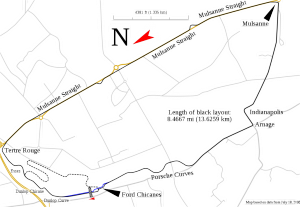Motor-sports is the holy grail for technological advancement in everyday motoring. The results can hope to emulate this basic idea only when the competing cars are tested during the race not only for speed but also exceptional reliability and safety. The 24 Hours of Le Mans (French: 24 Heures du Mans) is the world’s oldest sports car race in endurance racing, held annually since 1923 near the town of Le Mans, France. Commonly known as the Grand Prix of Endurance and Efficiency, race teams have to balance speed against the cars’ ability to run for 24 hours without sustaining mechanical damage to the car and manage the cars’ consumables, primarily fuel, tyres and braking materials. The endurance of the drivers is likewise tested as drivers frequently spend stints of over two hours behind the wheel before stopping in the pits and allowing a relief driver to take over the driving duties. Drivers then grab what food and rest they can before returning to drive another stint. Today it is mandated that three drivers share each competing vehicle.
 The race is organised by the Automobile Club de l’Ouest (ACO) and runs on the Circuit de la Sarthe, a circuit containing a mix of closed public roads and specialist motor racing circuit that are meant not only to test a car and driver’s ability to be quick, but also to last over a 24 hour period. The competing teams will race in groups called classes for cars of similar specification while at the same time competing for outright placing amongst all of the classes. Originally the race was held for cars as they were sold to the general public which were then called Sports Cars compared to the specialist racing cars used in Grands Prix. Over time the competing vehicles evolved away from their publicly-available road car roots and today the race is made of two classes specialised enclosed-bodywork two-seat Prototype sports cars and two classes of Grand Touring cars which bear much closer resemblance to high performance sports cars as sold to the public.
The race is organised by the Automobile Club de l’Ouest (ACO) and runs on the Circuit de la Sarthe, a circuit containing a mix of closed public roads and specialist motor racing circuit that are meant not only to test a car and driver’s ability to be quick, but also to last over a 24 hour period. The competing teams will race in groups called classes for cars of similar specification while at the same time competing for outright placing amongst all of the classes. Originally the race was held for cars as they were sold to the general public which were then called Sports Cars compared to the specialist racing cars used in Grands Prix. Over time the competing vehicles evolved away from their publicly-available road car roots and today the race is made of two classes specialised enclosed-bodywork two-seat Prototype sports cars and two classes of Grand Touring cars which bear much closer resemblance to high performance sports cars as sold to the public.
Competing teams have had a wide variety of organisation, ranging from competition departments of road car manufacturers who are eager to prove the supremacy of their products, to professional motor racing teams who represent their commercial backers, some of which are also road car manufacturers attempting to win without the expense of setting up their own teams, to amateur race teams, racing as much to compete in the famous race as to claim victory for their commercial partners.
The race is held near the height of the European summer in June, leading at times to very hot weather conditions for the drivers, particularly in closed roof vehicles whose cabins can heat up to uncomfortably hot temperatures with generally poor ventilation; rain, however, is not uncommon. The race begins in mid-afternoon, racing through the night and following morning before finishing at the same time the race started, the following day. Over the 24 hour period modern competitors will complete race distances well over 5,000 km (3,110 mi). The present record is 5,410 km (3,360 mi), recorded in the 2010 race. It is a distance over six times longer than the Indianapolis 500, or approximately 18 times longer than a Formula One Grand Prix.
The race has over the years inspired imitating races all over the globe, popularising the 24 Hour format at places like Daytona, Nurburgring, Spa-Francorchamps, Sebring and Mount Panorama. Presently the American Le Mans Series and the European based Le Mans Series of multi-event sports car championships have been spun off from 24 Hours of Le Mans regulations. Other races include the Le Mans Classic, a race for historic Le Mans race cars of years past held on the Circuit de la Sarthe, a motorcycle version of the race which is held on the shortened Bugatti version of the same circuit, a kart race (24 Heures Karting) and a truck race (24 Heures Camions).